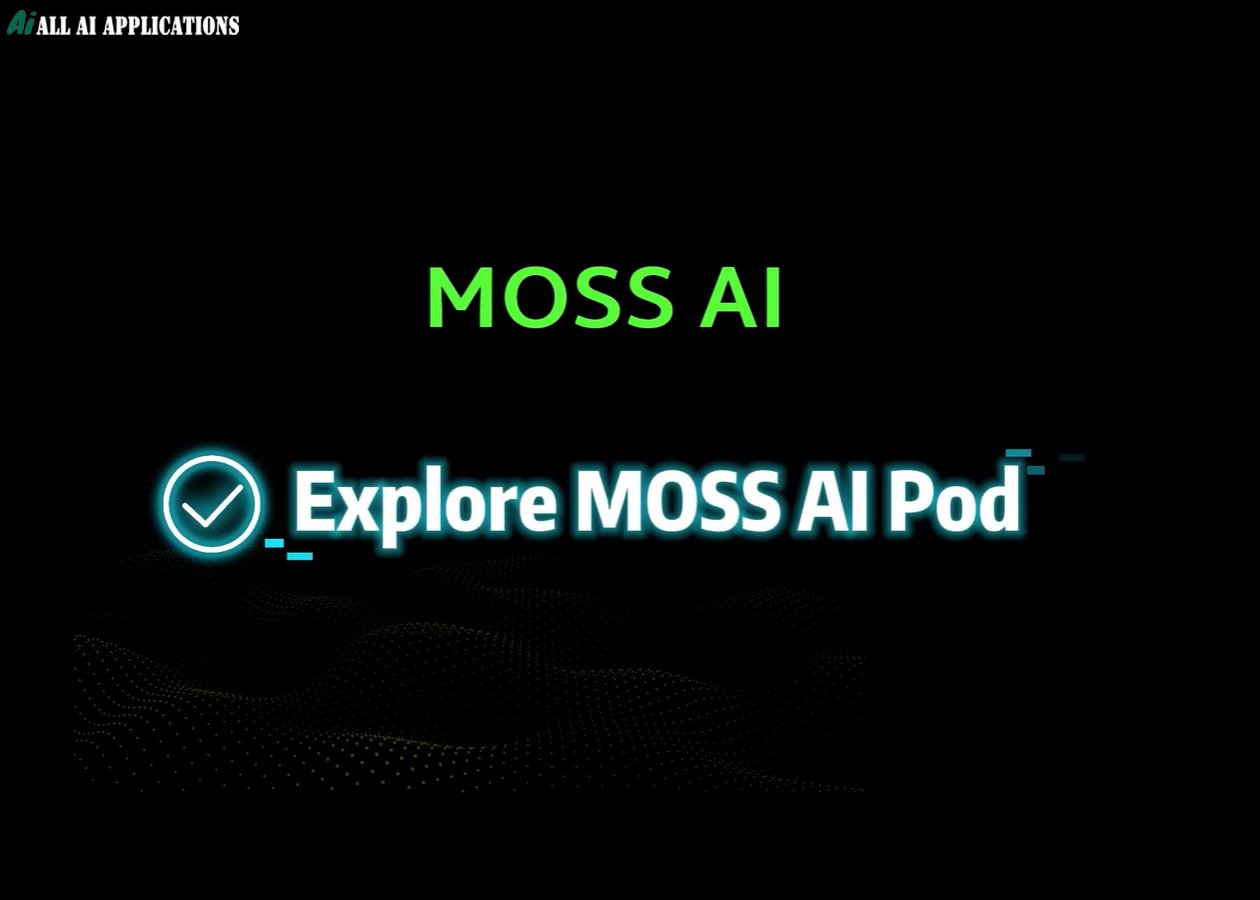MOSS AI is an open source conversational language model developed by Fudan University. It supports Chinese and English bilingual and multiple plug-ins, and has powerful language understanding and generation capabilities.
Definition and Origin
Definition
MOSS (Multilingual Open-Source Synthesizer) is the first ChatGPT-like model in China developed by the Natural Language Processing and Artificial Intelligence Laboratory of Fudan University, China. It is a multilingual open source synthesizer that can process a variety of natural language texts including Chinese, English, Japanese, Korean, etc., and has powerful language understanding and generation capabilities.
The release of MOSS is of great significance to the exploration and application of large language models in China, and has promoted the development of natural language processing technology.
Origin
MOSS was developed by Qiu Xipeng’s team at the Natural Language Processing Laboratory of Fudan University, China, and was officially released on February 20, 2023. Its name comes from the AI character in the movie “The Wandering Earth”, implying powerful intelligence and wide application potential.
Although the number of parameters of MOSS is an order of magnitude smaller than that of ChatGPT, its release still attracted widespread attention and popularity, demonstrating the strength of domestic teams in the field of natural language processing.
Core Technology
1. Model Architecture
MOSS is based on the Transformer architecture, a deep learning model that performs well in processing sequence data (such as natural language text). The Transformer architecture can make full use of the information in the input sequence through the self-attention mechanism to improve the performance of the model. MOSS adopts a large-scale Transformer framework with flexible settings in terms of input and output, which can adapt to a variety of different natural language processing tasks.
2. Parameter Scale
MOSS’s moss-moon series models have up to 16 billion parameters. The huge parameter scale enables the model to have stronger understanding and generation capabilities, and can more accurately capture the nuances in the language, thereby providing a more natural and smooth conversation experience.
3. Hardware Compatibility
MOSS supports multiple precision modes, including FP16, INT4, and INT8, to adapt to different hardware configurations. In FP16 precision mode, the model can run smoothly on a single A100 or A800 graphics card; in INT4 or INT8 precision mode, it can even run on a single graphics card, providing great flexibility for developers.
4. Multi-task learning
MOSS is not just a single natural language processing model, it also includes multiple tasks, such as text classification, named entity recognition, relationship extraction, etc. This multi-task learning framework enables the model to understand natural language more comprehensively, improve the effect and generalization ability of the model.
5. Data enhancement and learning rate scheduling
For training data, MOSS uses a variety of data enhancement strategies, including word replacement, deletion, and insertion, to improve the robustness and generalization performance of the model. At the same time, MOSS uses a gradient-based learning rate scheduling strategy to dynamically adjust the learning rate according to the training status of the model, helping the model avoid falling into the local optimal solution and improving the convergence speed and stability of the model.
6. Pre-training model optimization
MOSS has made a series of optimizations to the pre-training model, including similarity-based example filtering methods, unsupervised pre-training and other technologies, to improve the model’s effect and generalization performance.
Training data and pre-training
1. Pre-training data
MOSS is pre-trained on about 700 billion Chinese, English and code words, which come from a variety of data sources, including Wikipedia, Baidu Encyclopedia, news corpus, etc. Large-scale, high-quality pre-training data enables the model to learn rich language knowledge and world common sense.
2. Conversation data
In order to improve the model’s conversation ability, MOSS used about 1.1 million rounds of conversation data for fine-tuning. These data cover multiple levels such as usefulness, fidelity, and harmlessness, enabling the model to have the ability to follow instructions, multi-round conversations, and avoid harmful requests.
3. Plugin enhancement
In order to expand the application scenarios of the model, MOSS also used about 300,000 plug-in-enhanced multi-round conversation data for fine-tuning. These data enable the model to have stronger intent understanding and plug-in usage capabilities while supporting plug-ins such as search engines, text maps, calculators, and equation solvers.
Application scenarios
1. Natural language processing
MOSS has a wide range of applications in the field of natural language processing, including text automatic question answering, summarization, translation, and dialogue. Its powerful language understanding and generation capabilities enable it to perform well in processing various natural language tasks.
2. Computer vision
Although MOSS is primarily a natural language processing model, its powerful language understanding and generation capabilities also provide support for applications in the field of computer vision. For example, in tasks such as image recognition, target detection, and video analysis, MOSS can assist the understanding of computer vision models by generating natural language descriptions.
3. Robot control
In the field of robot control, MOSS can be used as a core component of an intelligent robot system to achieve autonomous decision-making and behavior planning. By understanding natural language instructions and generating natural language responses, MOSS makes the interaction between robots and humans more natural and convenient.
4. Metaverse
In the field of metaverse, MOSS is used in the development of generative artificial intelligence and virtual reality scenarios. For example, in generative artificial intelligence, MOSS can achieve human-machine co-creation, that is, people and AI jointly create works; in virtual reality scenarios, MOSS can assist in building virtual scenes by generating natural language descriptions.
5. Industry applications
MOSS has a wide range of applications in multiple industries, including smart customer service, smart home, autonomous driving, content intelligent review, copyright comprehensive services, digital publishing distribution, etc. Its powerful language understanding and generation capabilities enable it to perform well in handling various industry tasks, improving work efficiency and quality.
Application cases
1. Content intelligent review
MOSS cooperated with “Zebra China” to create a closed-loop composite review model of “AI+artificial”. By leveraging the powerful language understanding and generation capabilities of MOSS, efficient review and filtering of Internet content is achieved.
2. Copyright comprehensive services
MOSS has established an expert committee in conjunction with the China Copyright Association and others to promote the development of copyright value. By utilizing the natural language processing capabilities of MOSS, efficient management and distribution of copyrighted works are achieved.
3. Digital publishing and distribution
MOSS uses blockchain technology to realize the circulation and value anchoring of digital cultural products. By building a metaverse scene customization service based on MOSS, it provides users with a more convenient and efficient digital publishing and distribution experience.
4. E-commerce and media
In the field of e-commerce, MOSS provides e-commerce companies with efficient and high-quality product advertising image design services. By utilizing the image generation capabilities of MOSS, e-commerce companies can quickly generate advertising images that meet product characteristics and brand image.
In the field of media, MOSS provides short drama distribution companies with localized character face-changing and automatic translation functions. By utilizing the facial recognition and natural language processing capabilities of MOSS, short drama distribution companies can quickly localize and translate excellent short dramas in the company’s history, successfully opening up the local market.
Future development trends
1. Technological evolution
In the future, MOSS will develop in a more intelligent and humanized direction. By integrating more knowledge and skills, MOSS will be able to better simulate human thinking and behavior, so as to better serve mankind. At the same time, MOSS will also explore breakthroughs in computing paradigms such as quantum computing and neuromorphic computing to improve the efficiency and performance of the model.
2. Industry penetration
With the continuous development of technology, MOSS will be applied in more industries. Through deep integration with other industries, MOSS will help optimize the digitalization process of the industry and form a new digital economy space with innovative experience. For example, in the fields of intelligent manufacturing, medical health, smart cities, etc., MOSS will play an important role.
3. Open source and community
As an open source project, MOSS will continue to attract the participation and contribution of developers around the world. By continuously collecting preference feedback data, optimizing the factuality, security and response quality of the model, MOSS will continue to improve its performance and user experience. At the same time, MOSS will also actively participate in the construction and maintenance of the open source community to promote the healthy development of the open source ecosystem.
Industry application effect
1. Improve efficiency and quality
In the application of e-commerce, media and other fields, MOSS provides efficient and high-quality creative works. By leveraging the powerful language understanding and generation capabilities of MOSS, companies can quickly generate advertising images, videos and other content that are consistent with product features and brand image. This not only improves work efficiency and quality, but also saves time and energy.
2. Innovative market direction
In the application of short drama distribution, MOSS successfully opened up the local market through character localization face-changing and automatic translation functions. This innovative market direction not only increased the overseas revenue and market share of short drama distribution companies, but also provided useful reference and reference for other industries.
Algorithm principle
1. Reinforcement learning and semi-supervised learning
MOSS combines reinforcement learning and semi-supervised learning methods to achieve efficient training on large-scale data sets. Reinforcement learning enables the model to learn the best behavior strategy by interacting with the environment; semi-supervised learning uses the information of labeled data to learn model parameters and improve the generalization ability of the model.
2. Language model and pre-training
As a pre-training model, MOSS optimizes model parameters through reinforcement learning and semi-supervised learning. Pre-training enables the model to learn rich language knowledge and world common sense, providing a solid foundation for subsequent fine-tuning and application.
Technical implementation details
1. Multi-round dialogue and plug-in support
MOSS has the ability to have multi-round dialogues and use multiple plug-ins. By supporting Chinese and English and multiple plug-ins (such as search engines, text maps, calculators, etc.), MOSS provides users with a more convenient and efficient service experience.
2. Model optimization and monitoring
In order to improve the performance and stability of the model, MOSS has carried out a series of optimization measures on the pre-trained model. At the same time, MOSS also provides model monitoring and diagnostic tools to promptly discover and fix problems in the model.
3. Open source and community participation
As an open source project, MOSS’s source code, data, model parameters, etc. have been opened on platforms such as GitHub and Hugging Face. This has attracted the participation and contribution of developers around the world, and jointly promoted the continuous development and improvement of MOSS.
Open Source and Community
1. Open Source Ecosystem
MOSS’s open source ecosystem includes source code, data, model parameters and other aspects. By opening these resources, MOSS has attracted the participation and contribution of developers around the world, and jointly promoted the development and application of natural language processing technology.
2. Community Participation
MOSS actively invites the public to participate in internal testing and feedback collection. By continuously collecting preference feedback data, optimizing the factuality, security and response quality of the model, MOSS continuously improves its performance and user experience.
At the same time, MOSS also actively participates in the construction and maintenance of the open source community to promote the healthy development of the open source ecosystem.
Conclusion
As the first ChatGPT-like model in China, MOSS has demonstrated strong strength and application potential in the field of natural language processing.
Through continuous technological innovation and application expansion, MOSS will play an important role in more industries and promote the continuous progress and application of artificial intelligence technology.
FAQs
The following are common questions and answers about MOSS AI:
MOSS is a large multimodal AI model that supports text generation (such as papers, codes, conversations), image recognition, and speech recognition. It can also expand calculator, search and other functions through plug-ins, and is suitable for office, learning, creation and other scenarios.
Compared with ChatGPT, MOSS has a smaller parameter scale (16 billion), but a lower hardware threshold (can be run on a single consumer-grade graphics card), and supports Chinese and English bilingual and more plug-ins. Its open source feature allows users to customize training and is more flexible.
Based on the Transformer architecture, it improves language understanding capabilities through large-scale text data pre-training and combines multi-task learning (such as text classification and entity recognition) to support multi-round dialogues and long text processing.
It is recommended to use a single NVIDIA A100/A800 or two RTX 3090 graphics cards to support FP16 precision operation. Deployment requires the installation of Python environment and dependent libraries.
It may generate factual errors or biased content, which requires manual review. It is prohibited to use it for training other AI, reverse engineering or crawling data, and violations may result in legal liability.
Users need to actively verify the output to avoid spreading unverified information. The MOSS team continues to optimize the content filtering mechanism, but it cannot completely eliminate risks.
MOSS AI is designed to assist humans and improve production efficiency. However, in areas such as creativity and emotional understanding, humans are still irreplaceable, and the future will be more about collaboration rather than replacement.
You must comply with the usage policy and do not generate false information, malicious code, or deep fake content. Developers continue to monitor abnormal behavior, and users also need to be self-disciplined.
It is planned to expand the number of model parameters to hundreds of billions, optimize long text processing capabilities, and deepen applications in vertical fields such as medical care and education, while promoting the development of the open source community ecosystem.
You can contribute code through GitHub, submit usage feedback, or train customized AI applications based on open source models to participate in community co-construction.
MOSS AI agent is an AI system that can perceive the environment, make decisions, and take actions to achieve specific goals. It has basic capabilities such as memory, planning, taking actions, and using tools. It is autonomous, persistent, and adaptable, and can continuously learn and optimize its own behavior in complex environments.
The core functions of MOSS AI agent include:
Autonomous execution of tasks: such as stock analysis, travel planning, code development, etc., without human intervention.
Multi-field coverage: Covers multiple fields such as finance, education, medical care, e-commerce, etc., and handles tasks such as document writing, data analysis, and contract review.
Personalized customization: Remember user preferences and optimize output results.
MOSS AI agent adopts a hybrid architecture design, including a natural language understanding layer, a task planning engine, an API interface matrix, and an execution monitoring system. This design enables it to have multi-modal instruction parsing capabilities, dynamic resource scheduling mechanism, automatic rollback of exception handling, and cross-platform compatibility and adaptation.
MOSS AI agent has a wide range of application scenarios, including but not limited to:
Smart assistant: Provide personalized services such as schedule management and weather forecast.
Virtual customer service: In industries such as banking, e-commerce, and insurance, quickly answer user questions.
Autonomous driving car: Realize autonomous driving by sensing the environment, planning paths, and controlling vehicles.
Industrial robot: Realize automated production through perception and control technology.
Financial trading system: Realize the intelligence of transaction execution, risk assessment, customer service, and other links.
Medical diagnosis system: assists doctors in diagnosing diseases and formulating treatment plans.
No. MOSS AI agent supports pure natural language interaction, and users can use it without programming foundation.
MOSS AI agent is fully compatible with Windows, macOS and Linux systems.
Yes. All operations of MOSS AI agent are run in the local sandbox and are not uploaded to the cloud to ensure the security of data processing.
MOSS AI agent plans to open source reasoning modules to attract developers to jointly build tool call plug-ins and promote the development of the open source ecosystem.



